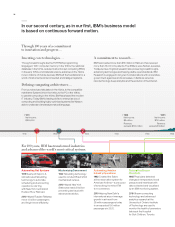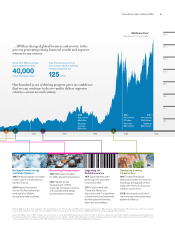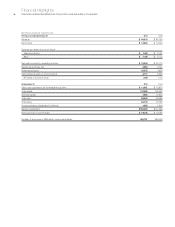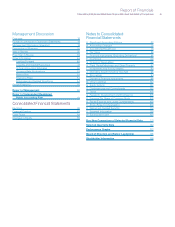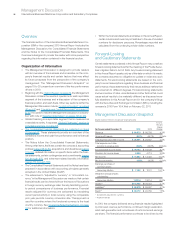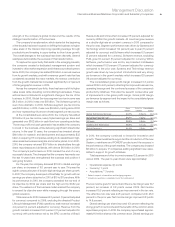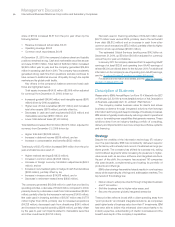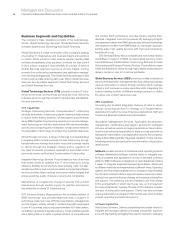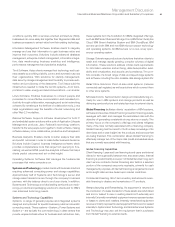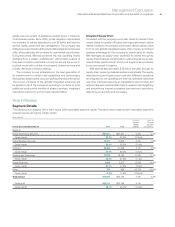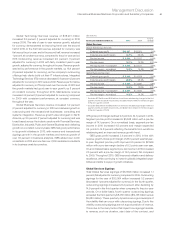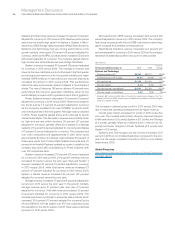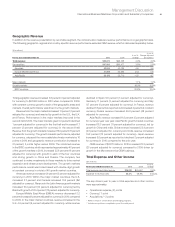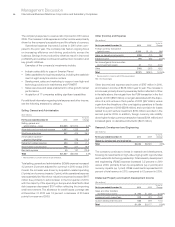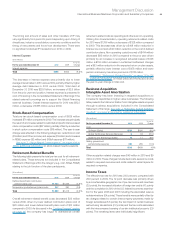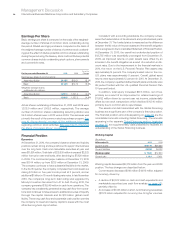IBM 2010 Annual Report Download - page 26
Download and view the complete annual report
Please find page 26 of the 2010 IBM annual report below. You can navigate through the pages in the report by either clicking on the pages listed below, or by using the keyword search tool below to find specific information within the annual report.24
Management Discussion
International Business Machines Corporation and Subsidiary Companies
IBM Worldwide Organizations
The following worldwide organizations play key roles in IBM’s
delivery of value to its clients:
• Sales and Distribution
• Research, Development and Intellectual Property
• Enterprise Transformation
• Integrated Supply Chain
Sales and Distribution
IBM has a significant global presence, operating in more than 170
countries, with an increasingly broad-based geographic distribution
of revenue. The company’s Sales and Distribution organization
manages a strong global footprint, with dedicated country-based
operating units focused on delivering client value. Within these
units, client relationship professionals work with integrated teams
of consultants, product specialists and delivery fulfillment teams
to improve clients’ business performance. These teams deliver
value by understanding the clients’ businesses and needs, and
then bring together capabilities from across IBM and an extensive
network of Business Partners to develop and implement solutions.
By combining global expertise with local experience, IBM’s
geographic structure enables dedicated management focus for
local clients, speed in addressing new market opportunities and
timely investments in emerging opportunities. The geographic
units align industry-skilled resources to serve clients’ agendas.
IBM extends capabilities to mid-market client segments by leverag-
ing industry skills with marketing, ibm.com and local Business
Partner resources.
Through its growth markets organization, the company contin-
ues to increase its focus on the emerging markets around the world
that have market growth rates greater than the global average—
countries within Southeast Asia, Eastern Europe, the Middle East
and Latin America. The company’s major markets include the
United States (U.S.), Canada, the United Kingdom (U.K.), France,
Germany, Italy, Japan, Denmark, Sweden, Switzerland, Austria,
Belgium, Finland, Greece, Iceland, Ireland, Malta, the Netherlands,
Portugal, Cyprus, Norway, Israel, Spain, the Bahamas and the
Caribbean region.
The majority of IBM’s revenue, excluding the company’s original
equipment manufacturer (OEM) technology business, occurs in
industries that are broadly grouped into six sectors:
• Financial Services: Banking, Financial Markets, Insurance
• Public: Education, Government, Healthcare, Life Sciences
•
Industrial: Aerospace and Defense, Automotive, Chemical and
Petroleum, Electronics
• Distribution: Consumer Products, Retail, Travel and Trans-
portation
• Communications: Telecommunications, Media and Entertain-
ment, Energy and Utilities
• General Business: Mainly companies with fewer than 1,000
employees
Research, Development and Intellectual Property
IBM’s R&D operations differentiate the company from its com-
petitors. IBM annually invests approximately $6 billion for R&D,
focusing on high-growth, high-value opportunities. The company
has rebalanced its internal R&D. Today, IBM’s portfolio is built
around networked, modularized and embedded technologies, as
well as business intelligence and analytics. In 2010, the company
was once again awarded more U.S. patents than any other company,
the 18th consecutive year IBM has been the patent leader. IBM’s
5,896 patents in 2010 were the most U.S. patents ever awarded to
one company in a single year. Over 70 percent of the patents issued
in 2010 were for software and services. The company’s R&D efforts
continue to push the frontiers of science and technology—from
analytics to cloud, to a computer named Watson that applied
advanced analytics to defeat the all-time champions on the
television quiz show, Jeopardy! Watson represents a tremendous
breakthrough in the ability of computers to understand natural
language and analyze massive amounts of data. It signals a new
era in computing, where computers will increasingly be built and
optimized for specific tasks and be able to learn.
In addition to producing world-class systems, software and
technology products, IBM innovations are also a major differen-
tiator in providing solutions for the company’s clients through
its services businesses. As an example, the math department at
IBM Research—the largest math department in the world housed
in one institution—helps enterprises more effectively capture
and analyze massive amounts of data to improve their business
performance.
The company will continue to actively seek intellectual property
protection for its innovations, while increasing emphasis on other
initiatives designed to leverage its intellectual property leadership.
The company’s investments in R&D also result in intellectual property
(IP) income of approximately $1 billion annually. Some of IBM’s tech-
nological breakthroughs are used exclusively in IBM products, while
others are licensed and may be used in either/both IBM products
and/or the products of the licensee. While the company’s various
proprietary intellectual property rights are important to its success,
IBM believes its business as a whole is not materially dependent on
any particular patent or license, or any particular group of patents
or licenses. IBM owns or is licensed under a number of patents,
which vary in duration, relating to its products. Licenses under pat-
ents owned by IBM have been and are being granted to others under
reasonable terms and conditions.
Enterprise Transformation
A key element of the company’s strategy has been focused on
becoming the premier globally integrated enterprise. In the early part
of the decade, the company drove implementation of a consistent
set of processes and standards worldwide to reduce inefficiencies
and improve collaboration. With its processes fully integrated, the
company implemented a new operating model with work shared in


